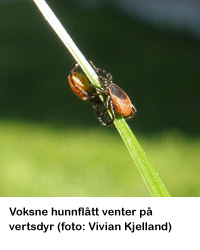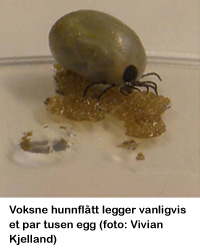
Ticks and Borrelia in Norway – Vivian Kjelland
Vivian Kjelland is a researcher/research advisor at Sørlandet Hospital Health Enterprise and at the University of Agder. The main focus of the research is ticks and Borrelia, but she is also working with other tick-borne bacteria and viruses. She defended her doctoral thesis entitled «Borrelia burgdorferi in Southern Norway – A piece of the puzzle» in June 2011.
Ticks are found in most parts of the world, and so far more than 900 species have been identified. The many tick species have different geographical distribution, and the most important species in Norway is the sheep tick (Ixodes ricinus) – or “skogflått” in Norwegian. It may be infected with a range of bacteria and viruses that may be transferred to animals and humans and cause disease. The most common pathogen is Borrelia, which is the causative agent of Lyme borreliosis (LB) (called Lyme disease in the USA). The tick may also be infected with other pathogens which may lead to the diseases tick babesiosis (”blodpiss” in Norwegian), anaplasmosis (“sjodogg” in Norwegian) and tick-borne encephalitis (TBE). A wide range of factors, as increased roe deer population density, regrowth of the vegetation and climatic changes, have led to an increase in the tick population density during the past decades. There are also indications of an increased geographical distribution of ticks in Norway. This has led to an increased prevalence and incidence of tick-borne diseases.
During a PhD-project, extensive field and laboratory work was performed to gain increased knowledge within the field. The work was done in collaboration with the Norwegian School of Veterinary Science (NVH), the University of Agder (UiA) and Sørlandet Hospital Health Enterprise (SSHF). In this project, ticks from southern Norway, where you find the highest incidence rates of tick-borne diseases in Norway, were collected and analyzed for Borrelia infection.
In average, 25 % of the host-seeking ticks were infected with Borrelia, but the results indicated large variation between locations. Borrelia consists of a group of several so called genotypes, where at least three, Borrelia burgdorferi sensu stricto, Borrelia garinii and Borrelia afzelii, cause human disease. All of the known pathogenic species found elsewhere in Europe were also present in the Norwegian tick population, but also here variations between locations were seen. A Swedish study is currently investigating the risk of infection after tick bite. (STING-studien)
The ticks acquire their blood meals from a wide range of vertebrate hosts, including birds, lizards and mammals, and these animals contribute differently to the LB-biology. The PhD-project included studies of several host animals (migratory birds, hares, roe deer and moose) in relation to ticks and Borrelia.
Migratory birds spread ticks

Birds, especially ground feeding species, are exposed to ticks and tick-borne diseases. Usually you will find a few ticks on each bird, but in some cases the entire face of the bird may be covered by small ticks. It is not known how or to which extent this affects the birds. During the project, ticks were collected from migratory birds, as they are considered important in the global dispersal of ticks and tick-borne pathogens through their migration. Ticks from 6538 migratory birds captured at Lista bird observatory were analyzed for Borrelia-infection. The study supports the notion that birds are important in the dispersal of ticks, and that they may be partly responsible for the heterogeneous distribution of the various genotypes of Borrelia in Europe.
However, despite of this there is no reason to stop feeding the birds. The ticks that may fall off the birds on or in the surroundings of the bird feeders are “full” after feeding on the birds, and are not looking for new prey until next year. Their survival until then depends on a range of factors, for instance the vegetation at the spot where they drop of has to provide shelter against desiccation and harsh winter conditions. By removing grass and bushes you will effectively destroy the ticks’ chance of survival.
Decline in hare population is not related to Borrelia-infection
The population of mountain hares in Southern Norway appears to be in severe decline, and hunters worry due to frequent findings of dead hares. As the tick population density has increased the past years, it was questioned whether Borrelia-infection after tick bite could lead to deaths among hares. To answer this, dead and diseased hares were collected from Aust-and Vest-Agder, and sent to necropsy at the Veterinary Institute. Tissue samples and ticks from the hares were analyzed for Borrelia-infection at UiA. The results indicate that disseminated borrelial infections in mountain hares rarely occur, and presumably do not play a central role in the suspected hare population decline. So what else could be the explanation for the decline in hare population? A wide range of possible causes exists, for instance it has previously been proposed that the decrease may be attributed to ecologic competition between roe deer and hare.
Less Borrelia in ticks that have fed on cervids?

The role of cervids in LB-ecology is a matter of debate. It is a well-known fact that areas with high density of deer will have high density of ticks (provided that other environmental factors as climate and vegetation are suitable for ticks). However, some animal species, for instance roe deer, seems to have a “diluting effect” on Borrelia. This may be explained by the presence of substances (“compliment”) in the blood of these species that kill the bacteria. If a tick is infected by Borrelia, the bacteria reside in the ticks’ gut. When the tick feeds on a roe deer, the compliment may kill the bacteria while they are still in the tick gut, and thereby reduce or remove the infection in the tick. To contribute to the knowledge concerning the impact of roe deer and moose on the prevalence of Borrelia infection in ticks, the Veterinary Institute organized the collection of one ear from roe deer and moose that were shot during the hunting season in the Agder counties. Ticks were collected from the ears, and analyzed for Borrelia infection at UiA. The results do in fact indicate a lower prevalence of Borrelia infection in ticks feeding on roe deer and moose compared to unfed ticks. Despite of this, the ticks may still be highly infectious in areas where high numbers of roe deer are present. Roe deer are good host-animals for the ticks; in average 52 ticks on each roe deer ear were found in present study! Hence, a high number of roe deer will imply a high number of ticks. Many of these will feed on other animals, and these may have the opposite effect on Borrelia; for instance are many species of mice effective reservoirs for the bacteria, and they will infect a high number of ticks.
Research on ticks and tick-borne diseases

Research on ticks and tick-borne diseases is important as the greatest risk to human health as a result of a warmer climate is likely to be an increase in vector-transmitted diseases. The sheep tick is likely to present the biggest challenge, as a warmer climate may provide a wider geographical distribution, higher tick population density, and longer periods of activity during the year. UiA and SSHF have defined research on ticks and tick-borne diseases as a joint focus area. An overall goal for UiA and SSHF is – through research-based knowledge – to contribute to the mapping of ticks and tick-borne diseases in Norway, prevent tick-borne diseases, optimize diagnostic methods, and to offer the best possible treatment to patients. Read more about the tick research on UiA here.
NLBF does not necessarily endorse the opinions expressed in this article; and the author of this article does not necessarily endorse NBLF’s points of view.
